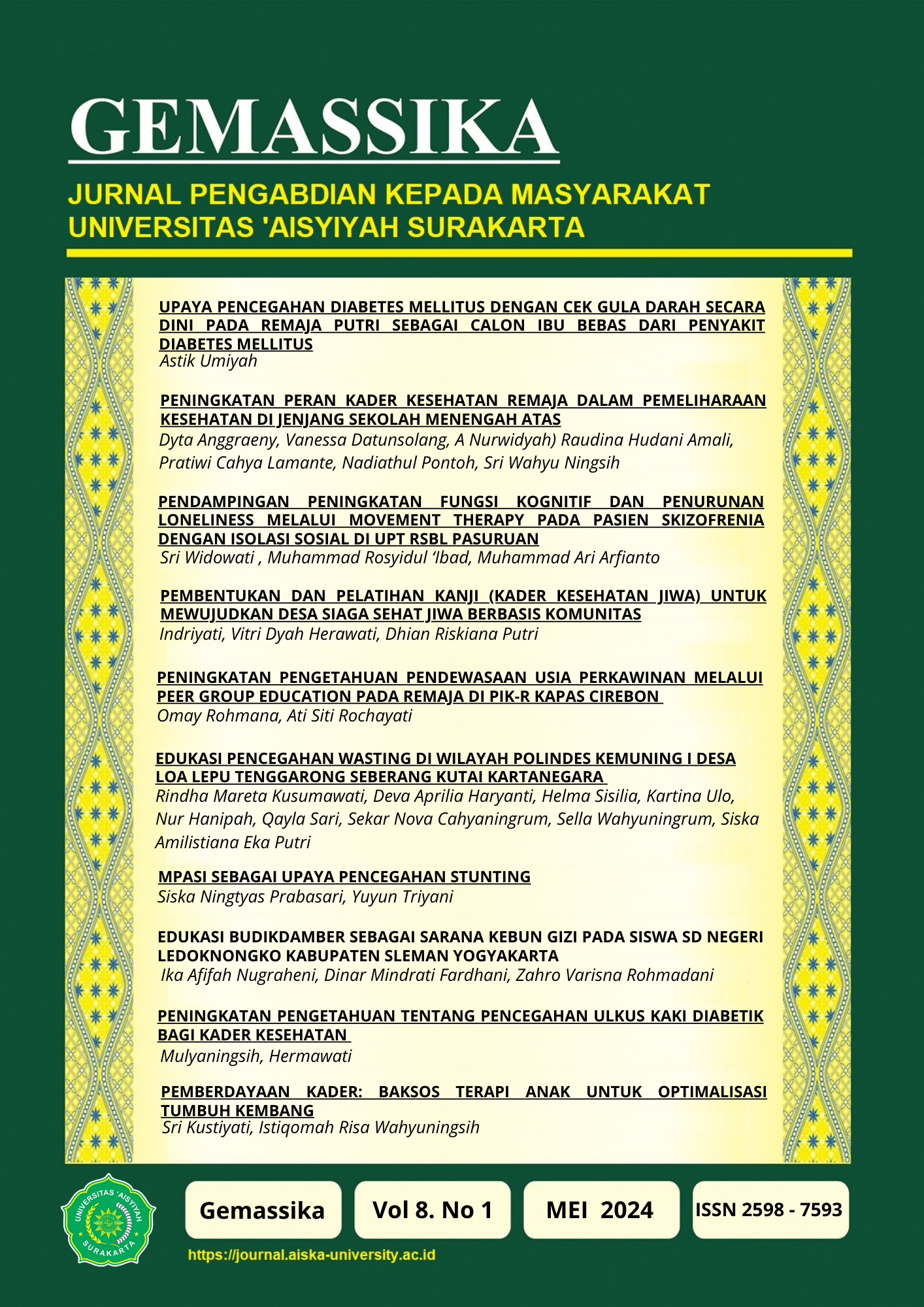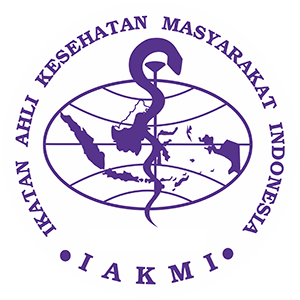PENINGKATAN PENGETAHUAN TENTANG PENCEGAHAN ULKUS KAKI DIABETIK BAGI KADER KESEHATAN
DOI:
https://doi.org/10.30787/gemassika.v8i1.1267Keywords:
Diabetes mellitus; Diabetic foot ulcers; exercise; foot examination; health educationAbstract
Background: Diabetes mellitus is a disorder in the body due to hyperglycemia. Diabetes can occur in everyone at any age. Diabetes mellitus is one of the top 10 disease patterns in Surakarta City. The prevalence of DM in Surakarta City is 12,105 cases in 2021. This number is for both insulin-dependent DM patients and non-insulin-dependent DM. Diabetic foot sufferers can experience neuropathic nerve disorders, structural changes, callus skin prints, skin and nail changes, foot injuries, infections, and vascular diseases. The results showed that 50% of DM sufferers had foot defects. As many as 24% were diagnosed with DM with peripheral neuropathy, and 11% had peripheral vascular disease. 60% of all patients are at risk of developing foot ulcers. DM sufferers who experience neuropathy or foot sensitivity can be at risk of developing diabetic foot disease. However, it can be prevented in various ways. For this reason, health cadres need to know what actions must be taken to prevent diabetic foot ulcers. Goals and outputs: to increase the knowledge of health cadres regarding the prevention of diabetic foot ulcers in patients with DM. The activities will be carried out to provide health education about DM and diabetic foot ulcers, teach how to examine feet, and teach foot exercises. Results and Conclusions: There is an increase in knowledge as evidenced by the analysis results, namely the difference between the level of knowledge before and after health education. In addition, there has also been an increase in foot care and exercise skills to prevent diabetic foot ulcers.
References
Abdulghani, Hamza Mohammad et al., 2018. “Prevalence of Diabetic Comorbidities and Knowledge and Practices of Foot Care among Diabetic Patients: A Cross-Sectional Study.” Diabetes, Metabolic Syndrome and Obesity: Targets and Therapy Volume 11: 417–25. https://www.dovepress.com/prevalence-of-diabetic-comorbidities-and-knowledge-and-practices-of-fo-peer-reviewed-article-DMSO.
Adiewere, P. et al., 2018. “A Systematic Review and Meta-Analysis of Patient Education in Preventing and Reducing the Incidence or Recurrence of Adult Diabetes Foot Ulcers (DFU).” Heliyon 4(5): e00614. https://doi.org/10.1016/j.heliyon.2018.e00614.
Akbar, Fredy, Darmiati Darmiati, Farmin Arfan, and Andi Ainun Zanzadila Putri. 2021. “Pelatihan Dan Pendampingan Kader Posyandu Lansia Di Kecamatan Wonomulyo.” Jurnal Abdidas 2(2): 392–97.
American Diabetes Association. 2017. “Standards of Medical Care in Diabetes—2017.” : 33–49.
Ardhany, Syahrida Dian, and Lamsiyah. 2018. “Tingkat Pengetahuan Pedagang Warung Tenda Di Jalan Yos Sudarso Palangkarayatentang Bahaya Penggunaan Minyak Jelantah Bagi Kesehatan.” Surya Medika 3(2): 62–68.
Bañuelos-barrera, Patricia, and Yolanda Banuelos-barrera. 2013. “Risk Factors of Foot Ulceration in Patients with Diabetes Mellitus Type 2.” Invest Educ Enferm 31(3): 442–49.
Colberg, S. R., Sigal, R. J., Yardley, J. E., Riddell, M. C., Dunstan, D. W., Dempsey, P. C., ... & Tate, D. F. (2016). Physical activity/exercise and diabetes: a position statement of the American Diabetes Association. Diabetes care, 39(11), 2065.
Dinas Kesehatan Kabupaten Sukoharjo. 2002. Profil Kesehatan Kabupaten Sukoharjo: Mewujudkan Masyarakat Sukoharjo Yang Lebih Makmur. Sukoharjo.
Dinkes Kota Surakarta. 2021. “Profil Kesehatan Kota Surakarta.” Profil Kesehatan Kota Surakarta (2).
LeMone, Priscilla, Karen M Burke, and Gerene Bauldoff. 2015. Buku Ajar Keperawatan Medikal Bedah. 5th ed. Jakarta: EGC.
Mulyaningsih et al., 2022. “Development of Gymnastics Models to Lower the Risk of Diabetic Ulcers in Diabetics.” Journal of Human Movement and Sports Sciences 10(5): 945–50.
Ningsih, Eka Sarofah, Siti Aisyah, Eva Nur Rohmah, and Kaka Nur Saida Sandana. 2022. “Peningkatan Peran Kader Dalam Posyandu Lansia.” Jurnal Ilmiah Multidisiplin Indonesia 2(1): 191–97.
Noya, Fransisca, Kadar Ramadhan, Deviana Laurenzy Tadale, and Ni Kadek Widyani. 2021. “Peningkatan Pengetahuan Dan Keterampilan Kader Melalui Pelatihan Kader Posyandu Remaja.” Jurnal Masyarakat Mandiri (JMM) 5(5): 2314–22. http://journal.ummat.ac.id/index.php/jmm/article/view/5257.
Palupi, Risqi Ekanti Ayuningtyas et al., 2023. “Penyuluhan Pentingnya Komunikasi Saat Terjadi Bencana Gempa Bumi Di Lingkungan Sekolah.” Hikmayo: Jurnal Pengabdian Masyarakat 2(1): 77.
Priyanto, Sigit, Junaiti Sahar, and Widyatuti. 2013. “Pengaruh Senam Kaki Terhadap Sensitivitas Kaki Dan Kadar Gula Darah Pada Aggregat Lansia Diabetes.” Prosiding Konferensi Nasional PPNI Jawa Tengah: 76–82.
Ramadhan, Kadar, Yafet Edimon Maradindo, Nurfatimah Nurfatimah, and Fahmi Hafid. 2021. “Kuliah Kader Sebagai Upaya Meningkatkan Pengetahuan Kader Posyandu Dalam Pencegahan Stunting.” JMM (Jurnal Masyarakat Mandiri) 5(4): 1751–59. http://journal.ummat.ac.id/index.php/jmm/article/view/5091.
Sigal, Ronald J. et al., 2018. “Physical Activity and Diabetes.” Canadian Journal of Diabetes 42: S54–63. https://doi.org/10.1016/j.jcjd.2017.10.008.
Silalahi, Elny Lorensi, Surita Ginting, and Anita Johana Marpaung. 2015. “Pengaruh Senam Kaki Terhadap Sensitivitas Kaki Pada Penderita Diabetes Melitus Di PUSKESMAS Medan Tuntungan Tahun 2015.” Jurnal Ilmiah PANNMED (2007): 147–52.
Soelistijo, Soebagijo Adi et al., 2015. Konsensus Pengelolaan Dan Pencegahan Diabetes Melitus Tipe 2 Di Indonesia 2015. PB PERKENI.
Wahyuni, Aria, and Nina Arisfa. 2016. “Senam Kaki Diabetik Efektif Meningkatkan Ankle Brachial Index Pasien Diabetes Melitus Tipe 2.” Jurnal Ipteks Terapan 2: 155–64. http://dx.doi.org/10.22216/jit.2015.v9i2.231.
Yunir, Em et al., 2015. Upaya Pencegahan Diabetes Tipe 2. 1st ed. Jakarta: Balai Penerbit FKUI.
Downloads
Published
How to Cite
Issue
Section
License
Copyright (c) 2024 GEMASSIKA: Jurnal Pengabdian Kepada Masyarakat

This work is licensed under a Creative Commons Attribution-NonCommercial 4.0 International License.












